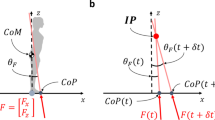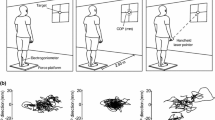Abstract
Human stance is inherently unstable. A small deviation from upright body orientation is enough to yield a gravitational component in the ankle joint torque, which tends to accelerate the body further away from upright (‘gravitational torque’; magnitude is related to body-space lean angle). Therefore, to maintain a given body lean position, a corresponding compensatory torque must be generated. It is well known that subjects use kinematic sensory information on body-space lean from the vestibular system for this purpose. Less is known about kinetic cues from force/torque receptors. Previous work indicated that they are involved in compensating external contact forces such as a pull or push having impact on the body. In this study, we hypothesized that they play, in addition, a role when the vestibular estimate of the gravitational torque becomes erroneous. Reasons may be sudden changes in body mass, for instance by a load, or an impairment of the vestibular system. To test this hypothesis, we mimicked load effects on the gravitational torque in normal subjects and in patients with chronic bilateral vestibular loss (VL) with eyes closed. We added/subtracted extra torque to the gravitational torque by applying an external contact force (via cable winches and a body harness). The extra torque was referenced to body-space lean, using different proportionality factors. We investigated how it affected body-space lean responses that we evoked using sinusoidal tilts of the support surface (motion platform) with different amplitudes and frequencies (normals ±1°, ±2°, and ±4° at 0.05, 0.1, 0.2, and 0.4 Hz; patients ±1° and ±2° at 0.05 and 0.1 Hz). We found that added/subtracted extra torque scales the lean response in a systematic way, leading to increase/decrease in lean excursion. Expressing the responses in terms of gain and phase curves, we compared the experimental findings to predictions obtained from a recently published sensory feedback model. For the trials in which the extra torque tended to endanger stance control, predictions in normals were better when the model included force cues than without these cues. This supports our notion that force cues provide an automatic ‘gravitational load compensation’ upon changes in body mass in normals. The findings in the patients support our notion that the presumed force cue mechanism provides furthermore vestibular loss compensation. Patients showed a body-space stabilization that cannot be explained by ankle angle proprioception, but must involve graviception, most likely by force cues. Our findings suggest that force cues contribute considerably to the redundancy and robustness of the human stance control system.







Similar content being viewed by others
References
Alexandrov AV, Frolov AA, Massion J (2001) Biomechanical analysis of movement strategies in human forward trunk bending. I Modeling. Biol Cybern 84:425–434
Creath R, Kiemel T, Horak F, Jeka JJ (2002) Limited control strategies with the loss of vestibular function. Exp Brain Res 145:323–333
Duysens J, Clarac F, Cruse H (2000) Load-regulating mechanisms in gait and posture: comparative aspects. Physiol Rev 80:83–132
Fitzpatrick R, Burke D, Gandevia SC (1996) Loop gain of reflexes controlling human standing measured with the use of postural and vestibular disturbances. J Neurophysiol 76:3994–4008
Heglund NC, Willems PA, Penta M, Cavagna GA (1995) Energy-saving gait mechanics with head-supported loads. Nature 375:52–58
Horak FB, Macpherson JM (1996) Postural orientation and equilibrium. In: Rowell L, Shepherd J (eds) Handbook of physiology, 1, exercise: regulation and integration of multiple systems. Oxford University Press, New York, pp 255–292
Johansson R, Magnusson M (1991) Human postural dynamics. Biomed Eng 18:413–437
Kavounoudias A, Roll R, Roll J-P (2001) Foot sole and ankle muscle inputs contribute jointly to human erect posture regulation. J Physiol 5532:869–878
Kiemel T, Oie KS, Jeka JJ (2002) Multisensory fusion and the stochastic structure of postural sway. Biol Cybern 87:262–277
Lagarias JC, Reeds JA, Wright MH, Wright PE (1998) Convergence properties of the Nelder-Mead Simplex method in low dimensions. SIAM J Optim 9:112–147
Maurer C, Mergner T, Bolha B, Hlavacka F (2000) Vestibular, visual, and somatosensory contributions to human control of upright stance. Neurosci Lett 281:99–102
Maurer C, Mergner T, Bolha B, Hlavacka F (2001) Human balance control during cutaneous stimulation of the plantar soles. Neurosci Lett 302:45–48
Maurer C, Mergner T, Peterka RJ (2006) Multisensory control of human upright stance. Exp Brain Res 171:231–250
Mergner T (2007) Modeling sensorimotor control of human upright stance. Prog Brain Res 165:283–297
Mergner T, Maurer C, Peterka RJ (2003) A multisensory posture control model of human upright stance. In: Prablanc C, Pélisson D, Rossetti Y (eds) Neural control of space coding and action production. Prog Brain Res 142:189–201
Mergner T, Schweigart G, Fennel L, Maurer C (2009) Posture control in vestibular loss patients. Ann NY Acad Sci (in press)
Meyer PF, Oddsson LI, De Luca CJ (2004) The role of plantar cutaneous sensation in unperturbed stance. Exp Brain Res 156:505–512
Peterka RJ (2002) Sensorimotor integration in human postural control. J Neurophysiol 88:1097–1118
Peterka RJ (2003) Simplifying the complexities of maintaining balance. IEEE Eng Med Biol Mag 22:63–68
Schweigart G, Mergner T (2009) Human stance control beyond steady state response and inverted pendulum simplification. Exp Brain Res 185:635–653
Stal F, Fransson PA, Magnusson M, Karlberg M (2003) Effects of hypothermic anesthesia of the feet on vibration-induced body sway and adaptation. J Vestib Res 13:39–52
van der Kooij H, de Vlugt E (2007) Postural responses evoked by platform pertubations are dominated by continuous feedback. J Neurophysiol 98:730–743
van der Kooij H, Jacobs R, Koopman B, Grootenboer H (1999) A multisensory integration model of human stance control. Biol Cybern 80:299–308
van der Kooij H, van Asseldonk E, van Helm FCT (2005) Comparison of different methods to identify and quantify balance control. J Neurosci Methods 145:175–203
Winter DA (1990) Biomechanics and motor control of human movement, 2nd edn. Wiley, New York
Acknowledgments
DFG Ma 2543/3-1; Me 715/5-3.
Author information
Authors and Affiliations
Corresponding author
Rights and permissions
About this article
Cite this article
Cnyrim, C., Mergner, T. & Maurer, C. Potential roles of force cues in human stance control. Exp Brain Res 194, 419–433 (2009). https://doi.org/10.1007/s00221-009-1715-7
Received:
Accepted:
Published:
Issue Date:
DOI: https://doi.org/10.1007/s00221-009-1715-7




